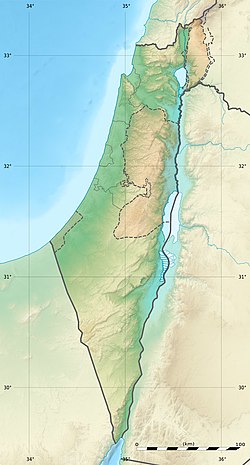
Back عسقلان القديمة Arabic Askalon (antiikin kaupunki) Finnish אשקלון (עיר עתיקה) HE اشکلون Urdu 阿斯卡隆 Chinese
𐤀𐤔𐤒𐤋𐤍 אַשְׁקְלוֹן Ἀσκάλων عَسْقَلَان | |
 Remains of the Church of Santa Maria Viridis | |
| Location | Southern District, Israel |
|---|---|
| Region | Southern Levant, Middle East |
| Coordinates | 31°39′43″N 34°32′46″E / 31.66194°N 34.54611°E |
| Type | Settlement |
| History | |
| Founded | c. 2000 BCE |
| Abandoned | 1270 CE |
| Periods | Bronze Age to Crusades |
| Cultures | Canaanite, Philistine, Phoenician, Crusaders |
| Site notes | |
| Excavation dates | 1815, 1920-1922, 1985-2016 |
| Archaeologists | Lady Hester Stanhope, John Garstang, W. J. Phythian-Adams, Lawrence Stager, Daniel Master |
Ascalon (Philistine: 𐤀𐤔𐤒𐤋𐤍, romanized: *ʾAšqalōn;[1] Hebrew: אַשְׁקְלוֹן, romanized: ʾAšqəlōn; Koinē Greek: Ἀσκάλων, romanized: Askálōn; Latin: Ascalon; Arabic: عَسْقَلَان, romanized: ʿAsqalān) was an ancient Near East port city on the Mediterranean coast of the southern Levant of high historical significance, including early on as a major Philistine city, and later as a much contested stronghold during the Crusades. Its importance diminished after the Mamluks destroyed its fortifications and port in 1270 in order to prevent any future military and logistical use by the Crusaders.
Traces of settlement in the area around Ascalon exist from the 3rd millennium BCE, with evidence of city fortifications emerging in the Middle Bronze Age. During the Late Bronze Age, Ashkelon was integrated into the Egyptian Empire, before becoming one of the five cities of the Philistine pentapolis following the migration of the Sea Peoples. The city was later destroyed by the Babylonians but was subsequently rebuilt.
Ascalon remained a major metropolis throughout antiquity and the early Middle Ages, before becoming a highly contested fortified foothold on the coast during the Crusades, when it became the site of two significant Crusader battles: the Battle of Ascalon in 1099, and the Siege of Ascalon in 1153. The Mamluk sultan Baybars ordered the destruction (slighting) of the city fortifications and the harbour in 1270 to prevent any further military use, though structures such as the Shrine of Husayn's Head survived. The nearby town of al-Majdal was established in the same period.
Ottoman tax records attest the existence of the village of Al-Jura adjacent to citadel walls from at least 1596.[2] That residual settlement survived until its depopulation in 1948. The modern Israeli city of Ashkelon takes its name from the ancient city.
- ^ Huehnergard, John (2018). "The Name Ashkelon". Eretz-Israel: Archaeological, Historical and Geographical Studies. 33: 91–97. JSTOR 26751887.
- ^ Hütteroth and Abdulfattah, 1977, p. 150
